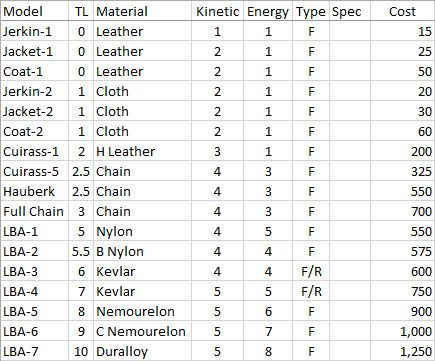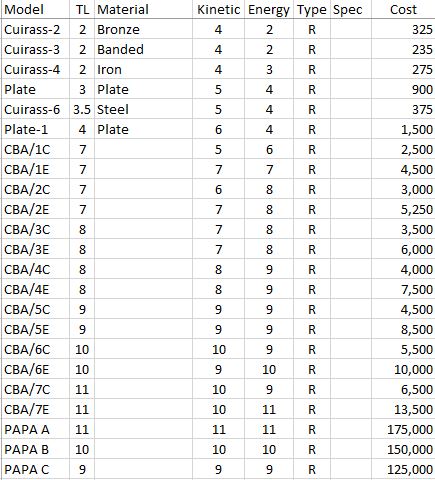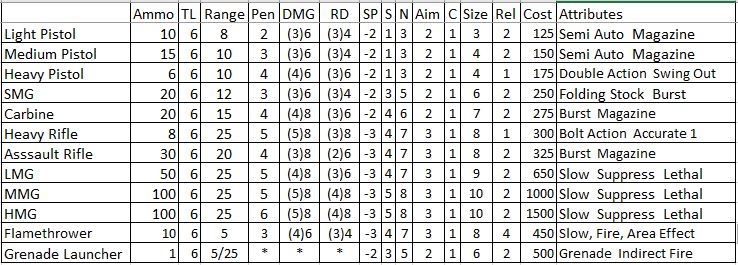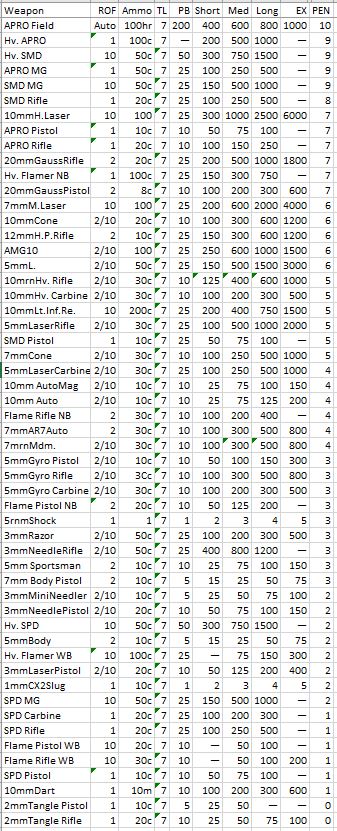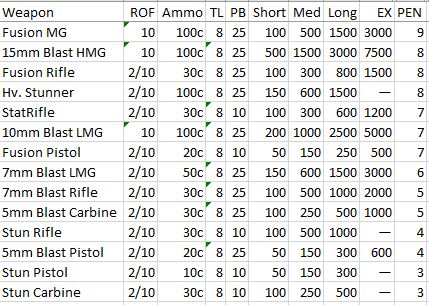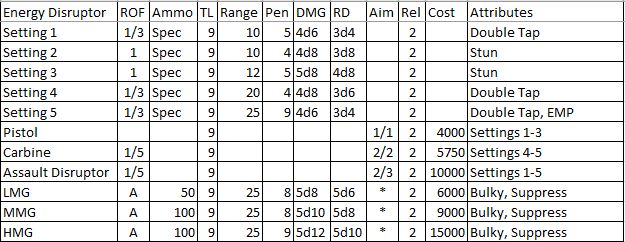Difference between revisions of "Future Imperfect chapter 7"
(→Armor) |
|||
| Line 10: | Line 10: | ||
=Armor= | =Armor= | ||
| − | [[image:armor.JPG]] | + | [[image:Armor-energy.JPG]] |
| + | |||
| + | '''TECH/9 BSU BELT SCREEN UNIT''': The BSU/9 is a small forcescreen | ||
| + | generator about the size of several packages of cigarettes and | ||
| + | is worn on the belt, It generates a standard screen capable | ||
| + | of defending against projectiles and energy weapons. Mass = 1 | ||
| + | kg. Powercell = 6 hr. continuous operation. | ||
| + | |||
| + | [[image:Armor-flexible.JPG]] | ||
| + | |||
| + | '''ARCHAIC ARMOR:''' All early forms of armor protection (pre- | ||
| + | Tech/5) are included in this grouping. Hide, leather, and cloth | ||
| + | armor also includes everyday garments made of such | ||
| + | material which are reasonably thick. Heavy fur coats, for | ||
| + | instance, are equivalent to Coat/1 hide armor. Similarly, heavy | ||
| + | winter cloth coats could be classed as roughly equivalent to | ||
| + | quilted cloth armor. Such protection can be obtained in early | ||
| + | cultures or may be manufactured to order in advanced | ||
| + | societies. | ||
| + | |||
| + | '''LBA LIGHT BODY ARMOR:''' LBA is personal armor designed to | ||
| + | protect the torso and abdomen from small arms fire and | ||
| + | sometimes from edged weapons in early Tech/5-6 versions. | ||
| + | Later models also provide protection against energy fire. Early | ||
| + | types are comparable to the rather bulky and heavy ‘bullet | ||
| + | proof vests’ and flak jackets of the 20th century on Terra. With | ||
| + | Tech/7 technology, a widespread use of lightweight synthetic | ||
| + | fibers like Kevlar made fairly compact and effective body | ||
| + | armor a possibility. | ||
| + | |||
| + | '''LBA/1''' is equivalent to the bullet-proof vest, made of nylon | ||
| + | reinforced with titanium steel plates. <br> | ||
| + | '''LBA/2''' is equivalent to the standard flak vest of the 1940s-1950s, | ||
| + | made of ballistic nylon.<br> | ||
| + | |||
| + | '''LBA/3''' is an early Kevlar model, reinforced with ceramic or light | ||
| + | metal plates.<br> | ||
| + | |||
| + | '''LBA/4''' is an improved Kevlar | ||
| + | model, reinforced with plates | ||
| + | of high tensile strength alloy.<br> | ||
| + | |||
| + | '''LBA/5''' is a Nemourelon ballistic | ||
| + | cloth model, reinforced with | ||
| + | light, strong plates of | ||
| + | Titanallay and rather resistant | ||
| + | to energy fire.<br> | ||
| + | |||
| + | '''LBA/6''' is an improved | ||
| + | Nemourelon model coated | ||
| + | with Insular to yield improved | ||
| + | anti-energy protection.<br> | ||
| + | |||
| + | '''LBA/7''' is a model of woven | ||
| + | Durallay coated with Insular to | ||
| + | yield good anti-energy | ||
| + | protection. | ||
| + | |||
| + | [[image:Armor-rigid.JPG]] | ||
| + | |||
| + | '''CBA COMBAT BODY ARMOR:''' All CBA is personal combat | ||
| + | armor designed to protect the entire body under battlefield | ||
| + | conditions. Some forms utilize a cuirass similar to the LBA types, | ||
| + | with a lighter armor protecting the arms and legs. Helmets are | ||
| + | also included, but these can be purchased separately at about | ||
| + | CR 25 plus 10% of the cost of the whole unit. | ||
| + | All CBA units have the possibility for optional features to be built | ||
| + | in at added cost: | ||
| + | |||
| + | Sealed Armor: For CR 1000, the armor is sealed against the | ||
| + | outside environment, effectively converting it into an armored | ||
| + | pressure suit proof against toxic gases and liquids, | ||
| + | law pressure conditions, etc. Like support and | ||
| + | breathing apparatus must be purchased separately. | ||
| + | |||
| + | Rad Shielding: For CR 750 per rad factor, CBA can | ||
| + | be shielded to the levels indicated in the tables | ||
| + | below. The mass of the unit is Increased by +2 kg | ||
| + | per rad factor of protection. | ||
| + | |||
| + | Other equipment-com gear, vision aids, jump packs, etc, can | ||
| + | be added at additional expense, It should be noted that the | ||
| + | overall mass of the armor will quickly increase as optional | ||
| + | features are installed and battle efficiency will eventually be | ||
| + | impaired by overloading. | ||
| + | |||
| + | '''PAPA POWER ASSISTED PERSONAL ARMOR:''' Some of the earliest | ||
| + | forms of Power Armor to appear in science fiction are the | ||
| + | battle armor types in ‘Doc’ Smith’s Lensman series. Robert A | ||
| + | Heinlein’s Starship Troopers and Joe Haldeman’s Forever War | ||
| + | provide more recent and detailed examples. Power Armor is a | ||
| + | heavily armored exoskeleton employing servomechanisms to | ||
| + | magnify the wearer’s strength. The result is that the CAP | ||
| + | (Combat Armor, Powered) Trooper becomes, in essence, a | ||
| + | one-man tank. Since the PAPA unit itself provides the power for | ||
| + | normal actions, with the wearer providing control rather than | ||
| + | ‘muscle,’ heavy activity can be performed for a considerable | ||
| + | period of time before the wearer becomes fatigued. When the | ||
| + | powercell is exhausted, the wearer will be unable to move the | ||
| + | suit by himself. | ||
| + | |||
| + | All PAPA units should be considered as armored vacuum suits | ||
| + | or armored space suits with mech strength. It is fully self-contained, | ||
| + | with electrically powered life support systems | ||
| + | capable of operation for up to 5 times the period indicated if | ||
| + | the suit powercell is replaced or recharged. Life support systems | ||
| + | include a heating/cooling unit to maintain livable conditions | ||
| + | inside the suit in all environments, waste reclamation of recycle | ||
| + | water and dehydrate solid wastes, air purifiers and a 4-hr. | ||
| + | emergency oxygen tank, self-sealing system to close hole and | ||
| + | leaks (some units have ‘nipper’ joints which can completely | ||
| + | close points on the limbs when sections are totally blown away, | ||
| + | while cauterizing the end of an amputated arm or leg), and | ||
| + | food and water for designed suit duration (5x powercell | ||
| + | duration). Food is in the form of concentrated ration pellets, | ||
| + | while water is recycled except for a 2 liter emergency tank. | ||
| + | Power Armor divides into 3 basic classifications: Scout, | ||
| + | Marauder, and Assault BattleArmour. Scout PAPA units are | ||
| + | typically used as ‘light’ reconnaissance armor by the military. | ||
| + | Civilians may be able to obtain Scout armor as well. A degree | ||
| + | of protection is sacrificed in the general interest of speed and | ||
| + | endurance. Marauder armor is standard BattleArmor typically | ||
| + | issued to Mobile Infantry. Assault BattleArmor is extra-heavy | ||
| + | Power Armor developed for very specialized use by the Terran | ||
| + | SpaceForces and the IPA. Armor protection in such Units may | ||
| + | attain heavy tank levels. However, Assault PAPA units are | ||
| + | exceedingly costly and therefore will never be encountered as | ||
| + | general issue items. | ||
Model: The type of armor. <br> | Model: The type of armor. <br> | ||
Revision as of 19:55, 8 May 2016
Equipment Reliability
All equipment will be rated for reliability, on a scale from Very Reliable, Reliable, Fragile and Experimental (V, R, F, E), in that order from left to right. If a possible breakdown is noted on the card, check the appropriate mishaps for the equipment type or use Master discretion to determine the result.
To determine if a mishap is possible, check the broken wrench portion of the action card, below armor penetration and above the clock face. If no letter appears, there is no effect. If a letter appears, check if it is either the same or to the left of the given reliability rating. If so, a breakdown is indicated. The exception is the V* card. If that card is drawn, and the equipment being used is very reliable, shuffle that card back into the deck (including all discarded cards, but nothing from the hands of the Master or Crew in play) and draw again. If that card is drawn again, there is a breakdown.
Catastrophic Breakdown
Most breakdowns are of the mundane type, such as a weapon jam or a loose wire. If, however, the V* is drawn and the equipment being used is not very reliable, reshuffle and draw again as indicated above. If the card drawn in this extra draw would indicate a breakdown for the equipment being used, then a catastrophic breakdown has occurred. Consult the appropriate table or use Master discretion to determine the effect.
Armor
TECH/9 BSU BELT SCREEN UNIT: The BSU/9 is a small forcescreen generator about the size of several packages of cigarettes and is worn on the belt, It generates a standard screen capable of defending against projectiles and energy weapons. Mass = 1 kg. Powercell = 6 hr. continuous operation.
ARCHAIC ARMOR: All early forms of armor protection (pre- Tech/5) are included in this grouping. Hide, leather, and cloth armor also includes everyday garments made of such material which are reasonably thick. Heavy fur coats, for instance, are equivalent to Coat/1 hide armor. Similarly, heavy winter cloth coats could be classed as roughly equivalent to quilted cloth armor. Such protection can be obtained in early cultures or may be manufactured to order in advanced societies.
LBA LIGHT BODY ARMOR: LBA is personal armor designed to protect the torso and abdomen from small arms fire and sometimes from edged weapons in early Tech/5-6 versions. Later models also provide protection against energy fire. Early types are comparable to the rather bulky and heavy ‘bullet proof vests’ and flak jackets of the 20th century on Terra. With Tech/7 technology, a widespread use of lightweight synthetic fibers like Kevlar made fairly compact and effective body armor a possibility.
LBA/1 is equivalent to the bullet-proof vest, made of nylon
reinforced with titanium steel plates.
LBA/2 is equivalent to the standard flak vest of the 1940s-1950s,
made of ballistic nylon.
LBA/3 is an early Kevlar model, reinforced with ceramic or light
metal plates.
LBA/4 is an improved Kevlar
model, reinforced with plates
of high tensile strength alloy.
LBA/5 is a Nemourelon ballistic
cloth model, reinforced with
light, strong plates of
Titanallay and rather resistant
to energy fire.
LBA/6 is an improved
Nemourelon model coated
with Insular to yield improved
anti-energy protection.
LBA/7 is a model of woven Durallay coated with Insular to yield good anti-energy protection.
CBA COMBAT BODY ARMOR: All CBA is personal combat armor designed to protect the entire body under battlefield conditions. Some forms utilize a cuirass similar to the LBA types, with a lighter armor protecting the arms and legs. Helmets are also included, but these can be purchased separately at about CR 25 plus 10% of the cost of the whole unit. All CBA units have the possibility for optional features to be built in at added cost:
Sealed Armor: For CR 1000, the armor is sealed against the outside environment, effectively converting it into an armored pressure suit proof against toxic gases and liquids, law pressure conditions, etc. Like support and breathing apparatus must be purchased separately.
Rad Shielding: For CR 750 per rad factor, CBA can be shielded to the levels indicated in the tables below. The mass of the unit is Increased by +2 kg per rad factor of protection.
Other equipment-com gear, vision aids, jump packs, etc, can be added at additional expense, It should be noted that the overall mass of the armor will quickly increase as optional features are installed and battle efficiency will eventually be impaired by overloading.
PAPA POWER ASSISTED PERSONAL ARMOR: Some of the earliest forms of Power Armor to appear in science fiction are the battle armor types in ‘Doc’ Smith’s Lensman series. Robert A Heinlein’s Starship Troopers and Joe Haldeman’s Forever War provide more recent and detailed examples. Power Armor is a heavily armored exoskeleton employing servomechanisms to magnify the wearer’s strength. The result is that the CAP (Combat Armor, Powered) Trooper becomes, in essence, a one-man tank. Since the PAPA unit itself provides the power for normal actions, with the wearer providing control rather than ‘muscle,’ heavy activity can be performed for a considerable period of time before the wearer becomes fatigued. When the powercell is exhausted, the wearer will be unable to move the suit by himself.
All PAPA units should be considered as armored vacuum suits or armored space suits with mech strength. It is fully self-contained, with electrically powered life support systems capable of operation for up to 5 times the period indicated if the suit powercell is replaced or recharged. Life support systems include a heating/cooling unit to maintain livable conditions inside the suit in all environments, waste reclamation of recycle water and dehydrate solid wastes, air purifiers and a 4-hr. emergency oxygen tank, self-sealing system to close hole and leaks (some units have ‘nipper’ joints which can completely close points on the limbs when sections are totally blown away, while cauterizing the end of an amputated arm or leg), and food and water for designed suit duration (5x powercell duration). Food is in the form of concentrated ration pellets, while water is recycled except for a 2 liter emergency tank. Power Armor divides into 3 basic classifications: Scout, Marauder, and Assault BattleArmour. Scout PAPA units are typically used as ‘light’ reconnaissance armor by the military. Civilians may be able to obtain Scout armor as well. A degree of protection is sacrificed in the general interest of speed and endurance. Marauder armor is standard BattleArmor typically issued to Mobile Infantry. Assault BattleArmor is extra-heavy Power Armor developed for very specialized use by the Terran SpaceForces and the IPA. Armor protection in such Units may attain heavy tank levels. However, Assault PAPA units are exceedingly costly and therefore will never be encountered as general issue items.
Model: The type of armor.
TL: Tech Level
Material: The type of material the armor is crafted from.
Impact: Armor value versus impact weapons.
Pierce/Slash: Armor value versus piercing and slashing weapons.
Energy: Armor value versus energy weapons.
Type: The armor classification (Flexible, Rigid, Energy)
Ranged Weapons
ROF: Rate of fire. If selective fire, all modes are listed.
Ammo: The type of ammunition the weapon uses.
TL: Tech Level
PB: Point blank range, in meters.
Short: Short range, in meters.
Med: Medium range, in meters.
Long: Long range, in meters.
Ex: Extreme range, in meters.
Pen: Penetration value of the weapon.
